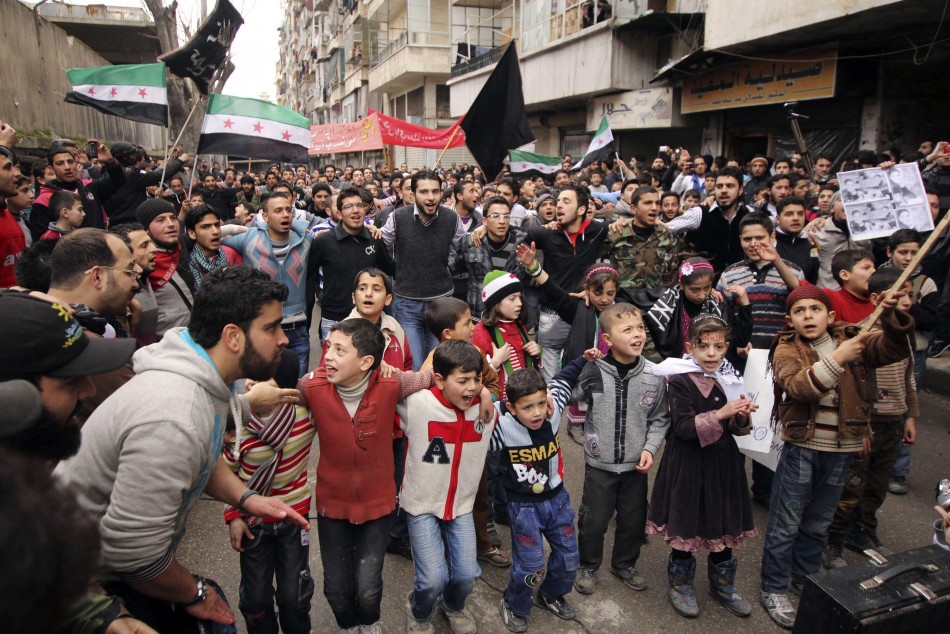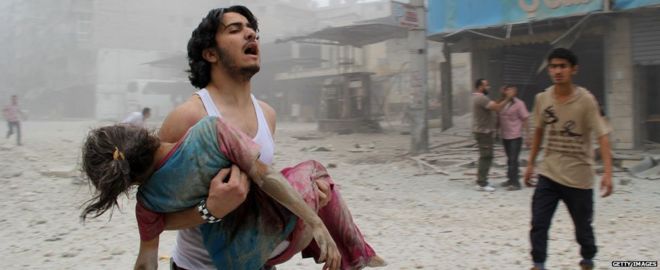Quick facts: What you need to know about the Syria crisis
Editor's note: This article was originally published on August 13, 2013; it was updated on September 3, 2015 to reflect the latest information.
Donate today to help Syrian families survive crisis and rebuild their lives ▸
Syria’s civil war is the worst humanitarian disaster of our time. The number of innocent civilians suffering — more than 11 million people are displaced, thus far — and the increasingly dire impact on neighboring countries can seem too overwhelming to understand.
But one fact is simple: millions of Syrians need our help. And the more aware people are of the situation, the more we can build a global response to reach them. Our lifesaving work — to connect people to the resources they need to survive and help their communities thrive — is only possible with your knowledge and support.
Sign a petition: Tell congress we must continue to support Syrian refugees ▸
So take a few minutes to understand the magnitude of this crisis. Read below to learn the facts behind the figures — and find out how you can help.
When did the crisis start?
Anti-government demonstrations began in March of 2011, part of the Arab Spring. But the peaceful protests quickly escalated after the government's violent crackdown, and rebels began fighting back against the regime.
By July, army defectors had loosely organized the Free Syrian Army and many civilian Syrians took up arms to join the opposition. Divisions between secular and Islamist fighters, and between ethnic groups, continue to complicate the politics of the conflict.
What is happening to Syrians caught in the war?
More than four years after it began, the full-blown civil war has killed over 220,000 people, half of whom are believed to be civilians. Bombings are destroying crowded cities and horrific human rights violations are widespread. Basic necessities like food and medical care are sparse.
The U.N. estimates that 7.6 million people are internally displaced. When you also consider refugees, more than half of the country’s pre-war population of 23 million is in need of urgent humanitarian assistance, whether they still remain in the country or have escaped across the borders.

Where are they fleeing to?
The majority of Syrian refugees are living in Jordan and Lebanon, where Mercy Corps has been addressing their needs since 2012. In the region’s two smallest countries, weak infrastructure and limited resources are nearing a breaking point under the strain.
In August 2013, more Syrians escaped into northern Iraq at a newly opened border crossing. Now they are trapped by that country's own insurgent conflict, and Iraq is struggling to meet the needs of Syrian refugees on top of more than one million internally displaced Iraqis — efforts that we are working to support.
An increasing number of Syrian refugees are fleeing across the border into Turkey, overwhelming urban host communities and creating new cultural tensions. Mercy Corps is working in these areas as well to help families meet their basic needs and find work.
Hundreds of thousands of refugees are also attempting the dangerous trip across the Mediterranean Sea from Turkey to Greece, hoping to find a better future in Europe. Not all of them make it across alive. Those who do make it to Greece still face steep challenges — resources are strained by the influx and services are minimal.
Learn how we're supporting Syrian refugees throughout the region ▸
How are people escaping?
Thousands of Syrians flee their country every day. They often decide to finally escape after seeing their neighborhoods bombed or family members killed.
The risks on the journey to the border can be as high as staying: Families walk for miles through the night to avoid being shot at by snipers or being caught by soldiers who will kidnap young men to fight for the regime.
How many refugees are there?
Four million Syrians have registered or are awaiting registration with the United Nations High Commission of Refugees, who is leading the regional emergency response.
Every year of the conflict has seen an exponential growth in refugees. In 2012, there were 100,000 refugees. By April 2013, there were 800,000. That doubled to 1.6 million in less than four months. There are now four million Syrians scattered throughout the region, making them the world's largest refugee population under the United Nations' mandate.
At this rate, the U.N. predicts there could be 4.27 million Syrian refugees by the end of 2015 — the worst exodus since the Rwandan genocide 20 years ago.
Do all refugees live in camps?
The short answer: no.
Jordan’s Za'atari, the first official refugee camp that opened in July 2012, gets the most news coverage because it is the destination for newly arrived refugees. It is also the most concentrated settlement of refugees: Approximately 81,500 Syrians live in Za'atari, making it the country’s fourth largest city. The formerly barren desert is crowded with acres of white tents, makeshift shops line a “main street” and sports fields and schools are available for children.
A new camp, Azraq, opened in April 2014, carefully designed to provide a sense of community and security, with steel caravans instead of tents, a camp supermarket, and organized "streets" and "villages."
Because Jordan’s camps are run by the government and the U.N. — with many partner organizations like Mercy Corps coordinating services — they offer more structure and support. But many families feel trapped, crowded, and even farther from any sense of home, so they seek shelter in nearby towns.
Iraq has set up a few camps to house the influx of refugees who arrived in 2013, but the majority of families are living in urban areas. And in Lebanon, the government has no official camps for refugees, so families have established makeshift camps or find shelter in derelict, abandoned buildings. In Turkey, the majority of refugees are trying to survive and find work, despite the language barrier, in urban communities.
Read more: Refugees forced to shelter in unlikely places ▸
The fact is, the majority of refugees live outside camps.
What conditions are refugees facing outside camps?
Some Syrians know people in neighboring countries who they can stay with. But many host families were already struggling on meager incomes and do not have the room or finances to help as the crisis drags on.
Refugees find shelter wherever they can. Our teams have seen families living in rooms with no heat or running water, in abandoned chicken coops and storage sheds.
See photos: Syrian refugees outside camps struggle to meet needs ▸
Most refugees must find a way to pay rent, even for derelict structures. Without any legal way to work in Jordan and Lebanon, they struggle to find odd jobs and accept low wages that often don’t cover their most basic needs. The situation is slightly better in the Kurdish Autonomous region of northern Iraq, where Syrian Kurds can legally work, but opportunities are now limited because of the conflict there. And language is still a barrier.
The lack of clean water and sanitation in crowded, makeshift settlements is an urgent concern. Diseases like cholera and polio can easily spread — even more life-threatening without enough medical services. In some areas with the largest refugee populations, water shortages have reached emergency levels; the supply is as low as 30 liters per person per day — one-tenth of what the average American uses.
Read our report about the water shortage in Jordan: Tapped Out ▸
The youngest refugees face an uncertain future. Some schools have been able to divide the school day into two shifts and make room for more Syrian students. But there is simply not enough space for all the children, and many families cannot afford the transportation to get their kids to school.
How many refugees are children?
According to the U.N., more than half of all Syrian refugees are under the age of 18. Most have been out of school for months, if not years.
The youngest are confused and scared by their experiences, lacking the sense of safety and home they need. The older children are forced to grow up too fast, finding work and taking care of their family in desperate circumstances.
See their art and photos: What it's like to grow up as a refugee ▸
Watch videos they made: Leaving home behind ▸
Is there enough assistance to reach everyone?
In December 2014, the U.N. issued its largest ever appeal for a single crisis — according to their estimates, $8.4 billion is necessary to meet the needs of all those affected by the crisis, both inside and outside Syria, an increase from last year's $6.5 billion. Yet that previous appeal was only funded less than 50 percent.
Many humanitarian organizations, including Mercy Corps, are partnering with the U.N., using both private contributions and funding from the international community to actively address the needs of Syrians caught in this terrible disaster. But so much more must be done.
What can we do to help?
Mercy Corps is currently addressing the urgent needs of 3.7 million people both inside Syria and in neighboring countries.
We are delivering food and clean water, improving shelters and providing families with clothes, mattresses and other household essentials. We are helping children cope with trauma and leading constructive activities to nurture their healthy development. And we are focused on helping host communities and refugees work together to mitigate tensions and find solutions to limited resources.
We’ve worked in the region for 20 years and are committed to helping Syrians and the countries hosting them for as long as it takes.
But as the number of those in need keeps increasing, your support will allow us do even more. Here’s how you can make a difference for Syrian refugees:
- Donate today. Every single contribution helps us provide even more food, water, shelter and support to Syrian families in desperate need of help.
- Tell your friends. Share this story or go to our Facebook page to post the infographic and spread the word about the millions who need us.
- Start a campaign. You can turn knowledge into action by setting up a personal fundraising page and asking your friends and family to contribute to our efforts to help Syrians fleeing the war.
- Sign a petition. Tell congress that we must continue to support Syrian refugees. Add your name to the list to stand in support with refugees.
comments powered by Disqus


























































































